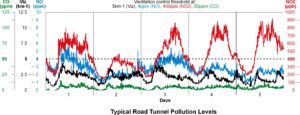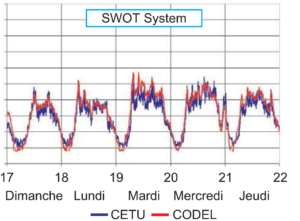Suporte mundial
Over 25 distributors and support centres worldwide
Contratos de manutenção flexíveis
Contratos específicos de fábrica sob medida com suporte 24 horas
30 years experience
Desenvolvendo, fabricando e instalando
How well are you controlling NO₂ in your Road Tunnel?
NO₂ Control in Road Tunnels
The need to minimise NO₂ exposure in road tunnels has been inhibited by the lack of suitable, low-maintenance sensors for measuring ppb levels of NO₂ . Recent improvements in technology have resulted in the introduction of not one but two competing techniques designed specifically for this application, making the possible control of tunnel NO₂ levels a reality rather than just a desire.
- NO₂ should now be a key control parameter.
NO₂ is particularly toxic. Levels higher than 1ppm can be harmful to healthy people. Lower levels as low as 0.1ppm will harm asthma sufferers.
- Current ventilation strategies based upon CO and visibility are inadequate.
It is assumed that if safe operating CO levels are maintained then other gaseous emissions will also be safe.
- CO levels are now too low to be an appropriate control parameter.
The introduction of catalytic converters has produced a major reduction in exhaust CO emissions. CO levels in tunnels rarely exceed the ventilation control trigger points.
- NO is not considered to be a harmful pollutant in tunnels.
At concentrations prevalent in tunnels NO is not itself a harmful pollutant and has no purpose as a control parameter. It has been used to infer NO₂ levels in the absence of low cost reliable NO₂ sensors.
- NO₂ cannot be inferred from the measurement of NO.
To infer NO₂ from NO measurements, the ratio of NO₂ /NO is taken to be 1:10. Recent tunnel test data shows that the ratio is actually variable to values greater than 1:3, resulting in serious under reporting of NO₂ values.
- New measurement techniques makes NO₂ a viable parameter for control.
The Codel TunnelTech 205 has been tested and approved by CETU in France for the measurement in the range of 0 to 2ppm in road tunnels. The Codel TunnelTech 205 uses a far simpler Single Wavelength Optical Transmissiometer (SWOT).
Recommendations for NO₂ Limits
World Health Organisation (2005) – Recommends an upper limit of 200μgm/m3 (100ppb) for a 1 hour exposure.
PIARC (2000) – Exposure to levels higher than 500μgm/m3 (250ppb) for 30minutes can impact on the health of sensitive people.
CETU France (Centre d’Etudes du Tunnels) – Following Circulaire 99.239 of 8 Juin 1999 (Ministière de la Santé) the following limits are recommended:
400ppb for 15 minutes – NO₂
50ppm for 30 minutes – CO
90ppm for 15 minutes – CO
NO₂: NO Ratio
Data from CETU illustrates the importance of NO₂ for ventilation control. Traditional control parameters CO & visibility are significantly below control threshold levels; NO₂ is persistently above the control threshold. The data also shows how the NO₂/NO ratios vary from 1:20 to 1:3. Inferring NO₂ levels from a measurement of NO is not reliable. A direct measurement of NO₂ is essential for control.
Sensor Comparison Data
CETU compared the output from the CODEL TunnelTech 205 NO₂ against a chemiluminescence NO/NO₂ analyser in month-long trials. The accompanying chart shows typical 5-days operational periods for each sensor and demonstrates the good agreement of our system against the standard analyser (Chemiluminescence principle is the reference method for NO/NO₂ measurement).
Faça uma pergunta
Para obter mais informações sobre qualquer um de nossos produtos, preencha nosso formulário e um membro da equipe responderá o mais rápido possível.
Você também pode ligar: +44(0)1629 814351



